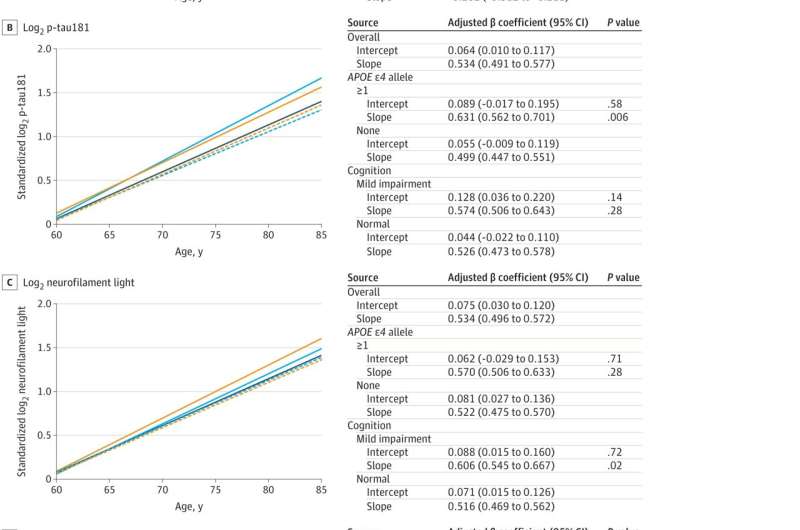This article has been reviewed according to Science X's editorial process and policies. Editors have highlighted the following attributes while ensuring the content's credibility:
fact-checked
peer-reviewed publication
trusted source
proofread
Study finds blood biomarkers can indicate dementia risk decades before symptoms

Before the advent of extensive research, Alzheimer's disease was only confidently diagnosed postmortem when medical professionals could observe physical changes in the brain associated with the disease, such as the appearance of protein plaques and neurological tangles, under a microscope.
But what if doctors could diagnose dementia from a simple blood draw when symptoms first start? Well, it's not too far from reality. Researchers are now measuring accumulations of proteins in the blood, called biomarkers, which they can use to track brain pathology in patients early on and identify those at risk for developing dementia later in life.
However, more research is needed to better understand the associations between blood biomarkers and dementia risk. To date, biomarker studies have typically examined older adults and have not followed individuals over time to see when these biomarkers emerge or how they change between midlife and late life.
Additionally, the development of Alzheimer's disease and related dementias, like other diseases, is influenced by factors, such as age, genetics, and the presence of co-morbidities. Before researchers can create an accurate blood test for Alzheimer's disease and other related dementias, they must fill in important gaps in their understanding of both biomarker trends in the body and other factors that may be driving disease progression. This knowledge can inform strategies to prevent disease and preserve brain health.
Priya Palta, Ph.D., MHS, an associate professor of neurology and an expert in assessing cardiovascular disease, aging, and dementia, told us, "There is a shortage of research on blood biomarker changes in individuals in their mid- to late-life, especially in diverse community-based cohorts, and on the relationships between biomarker changes and midlife cardiometabolic disorders," said Palta.
"Understanding these biomarker relationships could provide us further insights into how we can help maintain brain function in people at risk for dementia, monitor disease progression, or identify individuals who may benefit from treatment."
Now, a team from the University of North Carolina School of Medicine, New York University Grossman School of Medicine, Johns Hopkins University, and more, have found that certain blood biomarkers of Alzheimer's disease pathology and neurodegeneration in midlife and late life had strong associations with late-life dementia, especially a protein called neurofilament light chain, or NfL.
Their results were published in JAMA and were accompanied by an editorial discussing the findings.
What researchers know about biomarkers already
Several biomarkers can be measured in the blood which are reflective of the Alzheimer's disease process, wherein toxic proteins accumulate and cause damage, inflammation and death of neurons in the brain.
Tau is one of two hallmarks of Alzheimer's disease used to diagnose the disease at autopsy. It is a protein that supports and transports materials within neurons. In Alzheimer's disease, tau undergoes a biochemical change called phosphorylation and can be measured as Phosphorylated tau-181, causing the protein to break away from the neurons and form neurological tangles in the brain.
The other hallmark of the disease, Amyloid-beta (Aβ) peptides 42 (Aβ42) and 40 (Aβ40), are released from cells and are prone to aggregate, depositing in the brain as amyloid plaques. These proteins primarily accumulate in the brain, which causes their levels throughout the rest of the spinal cord and blood vessels to decrease. A low ratio of Aβ42/Aβ40 is an early indicator of Alzheimer's disease pathology.
As these proteins accumulate, neurons are damaged and die, leading to neurodegeneration. Neurofilament light chain (NfL), another structural component of neurons, breaks off the neurons when they are damaged. NfL is released into the cerebrospinal fluid (CSF) and accumulates in the bloodstream. Levels can rise before dementia symptoms are apparent, making high NfL levels a key early indicator for neuronal damage and disease.
These proteins and neuronal damage can also trigger inflammation in the brain, a common feature of Alzheimer's disease and related dementias. When neurons are inflamed, cells in the brain called astrocytes release Glial Fibrillary Acidic Protein (GFAP) into the CSF and the bloodstream.
How researchers made their findings
Researchers pulled data from the Atherosclerosis Risk in Communities Neurocognitive Study (ARIC-NCS), a study that recruited middle-aged adults in the late 1980s. ARIC-NCS originally focused on atherosclerosis and is now connecting cardiovascular risk and dementia.
Data from 1,525 ARIC-NCS participants were analyzed retrospectively. Researchers examined prior clinical information and stored blood samples, as well as demographic data, such as race, age, and education level.
Researchers found that the Aβ42/Aβ40 ratio decreased with age, whereas p-tau181, NfL, and GFAP increased as participants grew older, indicating neurodegeneration. They also found that midlife hypertension and diabetes were associated with a more rapid rise in NfL and GFAP. Overall, they determined that all blood biomarkers in late life had a strong association with late-life dementia.
These findings also demonstrate how disease-related changes can be identified in the blood nearly 20 years before dementia emerges at the population level; however more work is needed to identify specific biomarkers that can be used to individually diagnose Alzheimer's disease and related dementias at this early stage.
The study underscores the utility of monitoring blood biomarkers for Alzheimer's disease-related pathology and neurodegeneration in assessing dementia risk.
More information: Yifei Lu et al, Changes in Alzheimer Disease Blood Biomarkers and Associations With Incident All-Cause Dementia, JAMA (2024). DOI: 10.1001/jama.2024.6619
Stephen Salloway et al, Are Blood Tests for Alzheimer Disease Ready for Prime Time?, JAMA (2024). DOI: 10.1001/jama.2024.12814





















